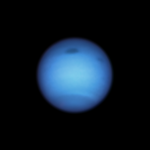
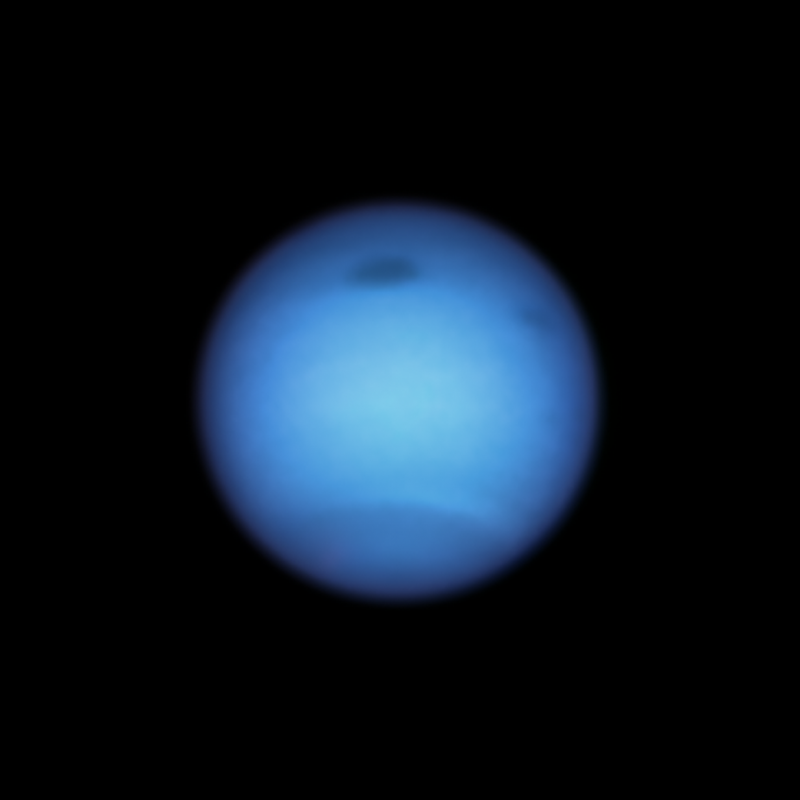
The large dark spot (top center) and its smaller companion (top right) on Neptune as seen by the Hubble Space Telescope in 2020. The large dark spot – discovered in 2018 – unexpectedly changed direction and drifted back the way that it had come. The smaller storm is thought to be a fragment of the larger storm. Image via NASA/ ESA/ STScI/ M.H. Wong (University of California, Berkeley)/ L.A. Sromovsky /P.M. Fry (University of Wisconsin-Madison).
Like its giant siblings Jupiter, Saturn and Uranus, Neptune has massive storms in its churning atmosphere which can be seen in Earth’s most powerful telescopes. Scientists have been tracking one of Neptune’s large spots, first seen by the Hubble Space Telescope in September 2018. This time, the storm did something unanticipated. It changed direction, saving itself from expected disintegration, at least for now. The surprising development was announced by Hubble astronomers on December 15, 2020 and presented at the fall meeting of the American Geophysical Union on that same day.
The 2021 lunar calendars are here! Going fast. Order yours before they’re gone!
This Neptune storm is wider than the Atlantic Ocean, at 4,600 miles (7,403 km) across. It’s the fourth dark storm on Neptune seen by Hubble since 1993. Previously, two other similar storms, including Neptune’s Great Dark Spot, had been seen up close by the Voyager 2 spacecraft back in 1989 during the historic flyby of Neptune. Unfortunately, they had vanished before Hubble came on the scene in 1990 and could take a look.
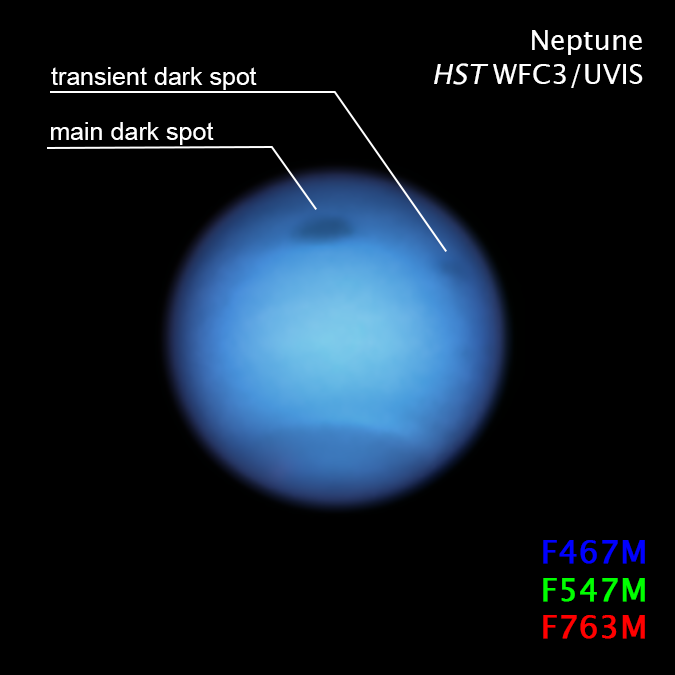
Here’s the smaller dark spot, which – according to the scientists – is likely a fragment that broke off the larger dark spot. Image via NASA/ ESA/ STScI/ M.H. Wong (University of California, Berkeley)/ L.A. Sromovsky/ P.M. Fry (University of Wisconsin-Madison).
The change in direction of this newest storm was not the only unusual thing about it. It also featured a noticeable lack of smaller, bright, feathery clouds, which had often been seen above Neptune’s dark spots. According to the scientists, those clouds disappeared when the dark spot stopped moving southward. The bright clouds are composed of methane ice crystals that form when gases are diverted upward over the dark spots and freeze into crystals.
The large dark spot also had a smaller companion – dubbed “dark spot jr.” – first spotted in January 2020, that astronomers think may have broken off from the main storm. This smaller spot did eventually fade away. As Michael Wong of the University of California, Berkeley, explained:
We are excited about these observations because this smaller dark fragment is potentially part of the dark spot’s disruption process. This is a process that’s never been observed. We have seen some other dark spots fading away, and they’re gone, but we’ve never seen anything disrupt, even though it’s predicted in computer simulations.
The new larger storm began its life in the northern hemisphere of Neptune and then began to gradually drift southward toward the planet’s southern hemisphere. As seen in observations of other such storms, that is where they start to disintegrate. But not this time. Instead, the storm was observed to have slowed down and changed direction by August 2020, moving back northward from where it had come. This was the first time such behavior was noticed in 30 years of Hubble observations.
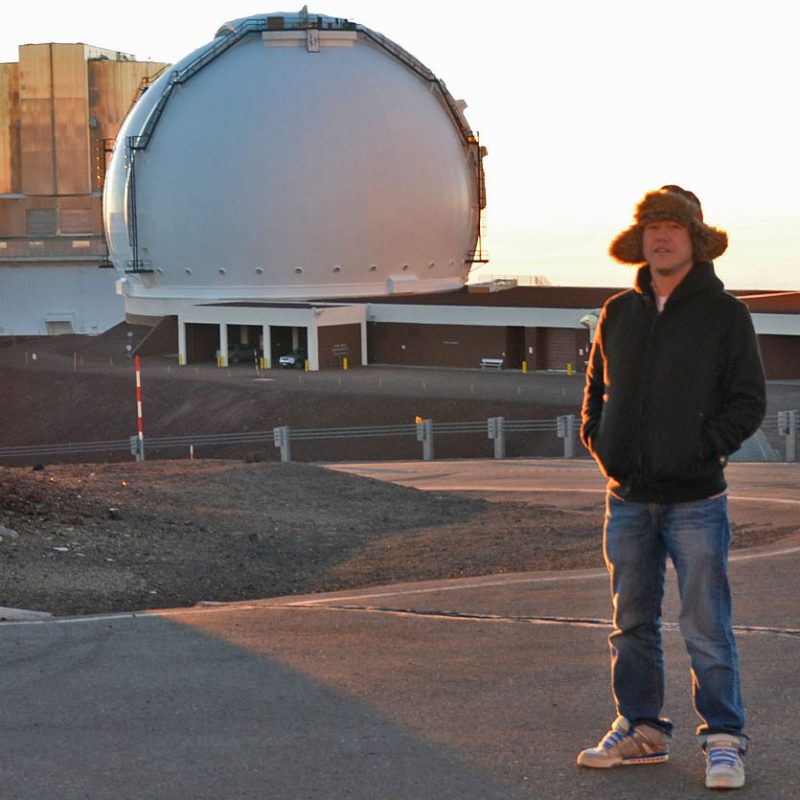
Michael Wong at the University of California, Berkeley, lead author of the new paper about Neptune’s dark spots. Image via University of California, Berkeley.
Interestingly, the smaller dark spot appeared about the same time that the larger storm reversed course and started going back in the direction it had come from. This newer spot was about 3,900 miles (6,276 km) across, and appeared on the side of the larger spot that faced toward Neptune’s equator. This was the area where some computer simulations suggested a disruption to the larger spot could occur, but the timing didn’t seem to match. Wong said:
When I first saw the small spot, I thought the bigger one was being disrupted. I didn’t think another vortex was forming because the small one is farther towards the equator. So it’s within this unstable region. But we can’t prove the two are related. It remains a complete mystery.
It was also in January [2020] that the dark vortex stopped its motion and started moving northward again. Maybe by shedding that fragment, that was enough to stop it from moving towards the equator.
Neptune’s storms are similar those on the other gas giants and ice giants (Neptune is an ice giant) and can grow in size to easily dwarf the largest hurricanes or cyclones on Earth, becoming as large as Earth itself. Unlike earthly hurricanes, they are high-pressure systems that form at mid-latitudes before migrating closer to the equator. In the northern hemisphere, they rotate clockwise due to the Coriolis Effect. But that effect weakens as the storms approach the equator, and the storms ultimately disintegrate.
That is the general scenario that plays out as Neptunian storms develop and then eventually break apart. But in this instance, the storm didn’t quite make it into the “kill zone” beyond the equator. As Wong noted:
It was really exciting to see this one act like it’s supposed to act and then all of a sudden it just stops and swings back. That was surprising.
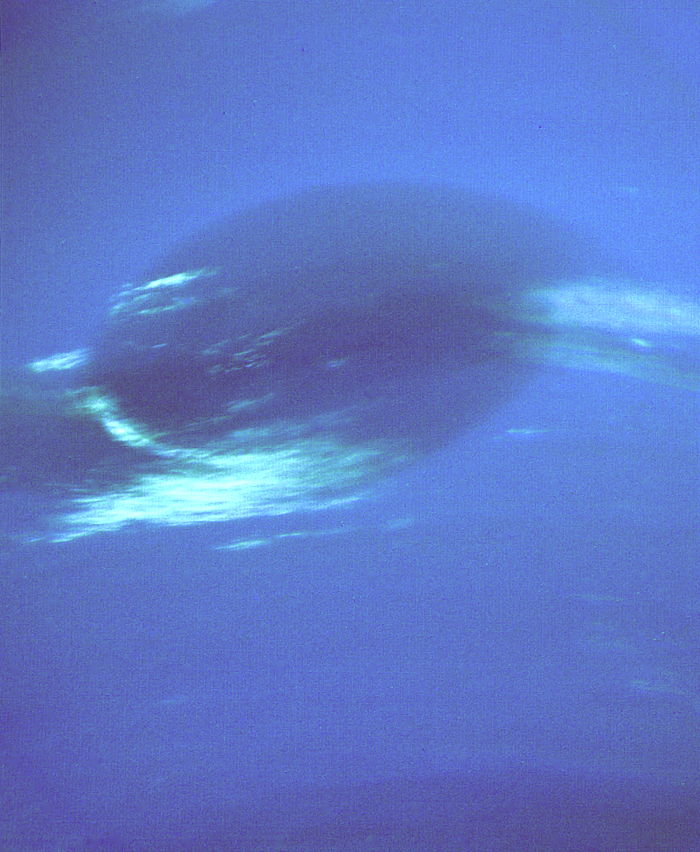
The Great Dark Spot on Neptune as seen by Voyager 2 in 1989. The white feathery clouds above it are composed of methane ice crystals. Image via NASA/ JPL/ Wikipedia.
It’s not known yet whether dark spot jr. also survived, but scientists are continuing to analyze the data from Hubble. The new observations also provide valuable clues as to how Neptune’s atmosphere behaves overall.
Hubble has played a central role in observing these spots on Neptune, especially since no other spacecraft has yet visited the planet since Voyager 2. According to Amy Simon at NASA’s Goddard Space Flight Center:
We wouldn’t know anything about these latest dark spots if it wasn’t for Hubble. We can now follow the large storm for years and watch its complete life cycle. If we didn’t have Hubble, then we might think the Great Dark Spot seen by Voyager in 1989 is still there on Neptune, just like Jupiter’s Great Red Spot. And, we wouldn’t have known about the four other spots Hubble discovered.
Until a new mission is (hopefully) eventually launched, telescopes like Hubble will continue to observe the mysterious dark spots of Neptune.
Bottom line: A large, dark storm on Neptune unexpectedly changed direction, saving itself from looming destruction in the process. It may also have produced a smaller companion storm.
Source: Neptune’s NDS-2018: The Dark Vortex That Would Not Die
from EarthSky https://ift.tt/34VqDP4


The large dark spot (top center) and its smaller companion (top right) on Neptune as seen by the Hubble Space Telescope in 2020. The large dark spot – discovered in 2018 – unexpectedly changed direction and drifted back the way that it had come. The smaller storm is thought to be a fragment of the larger storm. Image via NASA/ ESA/ STScI/ M.H. Wong (University of California, Berkeley)/ L.A. Sromovsky /P.M. Fry (University of Wisconsin-Madison).
Like its giant siblings Jupiter, Saturn and Uranus, Neptune has massive storms in its churning atmosphere which can be seen in Earth’s most powerful telescopes. Scientists have been tracking one of Neptune’s large spots, first seen by the Hubble Space Telescope in September 2018. This time, the storm did something unanticipated. It changed direction, saving itself from expected disintegration, at least for now. The surprising development was announced by Hubble astronomers on December 15, 2020 and presented at the fall meeting of the American Geophysical Union on that same day.
The 2021 lunar calendars are here! Going fast. Order yours before they’re gone!
This Neptune storm is wider than the Atlantic Ocean, at 4,600 miles (7,403 km) across. It’s the fourth dark storm on Neptune seen by Hubble since 1993. Previously, two other similar storms, including Neptune’s Great Dark Spot, had been seen up close by the Voyager 2 spacecraft back in 1989 during the historic flyby of Neptune. Unfortunately, they had vanished before Hubble came on the scene in 1990 and could take a look.

Here’s the smaller dark spot, which – according to the scientists – is likely a fragment that broke off the larger dark spot. Image via NASA/ ESA/ STScI/ M.H. Wong (University of California, Berkeley)/ L.A. Sromovsky/ P.M. Fry (University of Wisconsin-Madison).
The change in direction of this newest storm was not the only unusual thing about it. It also featured a noticeable lack of smaller, bright, feathery clouds, which had often been seen above Neptune’s dark spots. According to the scientists, those clouds disappeared when the dark spot stopped moving southward. The bright clouds are composed of methane ice crystals that form when gases are diverted upward over the dark spots and freeze into crystals.
The large dark spot also had a smaller companion – dubbed “dark spot jr.” – first spotted in January 2020, that astronomers think may have broken off from the main storm. This smaller spot did eventually fade away. As Michael Wong of the University of California, Berkeley, explained:
We are excited about these observations because this smaller dark fragment is potentially part of the dark spot’s disruption process. This is a process that’s never been observed. We have seen some other dark spots fading away, and they’re gone, but we’ve never seen anything disrupt, even though it’s predicted in computer simulations.
The new larger storm began its life in the northern hemisphere of Neptune and then began to gradually drift southward toward the planet’s southern hemisphere. As seen in observations of other such storms, that is where they start to disintegrate. But not this time. Instead, the storm was observed to have slowed down and changed direction by August 2020, moving back northward from where it had come. This was the first time such behavior was noticed in 30 years of Hubble observations.

Michael Wong at the University of California, Berkeley, lead author of the new paper about Neptune’s dark spots. Image via University of California, Berkeley.
Interestingly, the smaller dark spot appeared about the same time that the larger storm reversed course and started going back in the direction it had come from. This newer spot was about 3,900 miles (6,276 km) across, and appeared on the side of the larger spot that faced toward Neptune’s equator. This was the area where some computer simulations suggested a disruption to the larger spot could occur, but the timing didn’t seem to match. Wong said:
When I first saw the small spot, I thought the bigger one was being disrupted. I didn’t think another vortex was forming because the small one is farther towards the equator. So it’s within this unstable region. But we can’t prove the two are related. It remains a complete mystery.
It was also in January [2020] that the dark vortex stopped its motion and started moving northward again. Maybe by shedding that fragment, that was enough to stop it from moving towards the equator.
Neptune’s storms are similar those on the other gas giants and ice giants (Neptune is an ice giant) and can grow in size to easily dwarf the largest hurricanes or cyclones on Earth, becoming as large as Earth itself. Unlike earthly hurricanes, they are high-pressure systems that form at mid-latitudes before migrating closer to the equator. In the northern hemisphere, they rotate clockwise due to the Coriolis Effect. But that effect weakens as the storms approach the equator, and the storms ultimately disintegrate.
That is the general scenario that plays out as Neptunian storms develop and then eventually break apart. But in this instance, the storm didn’t quite make it into the “kill zone” beyond the equator. As Wong noted:
It was really exciting to see this one act like it’s supposed to act and then all of a sudden it just stops and swings back. That was surprising.

The Great Dark Spot on Neptune as seen by Voyager 2 in 1989. The white feathery clouds above it are composed of methane ice crystals. Image via NASA/ JPL/ Wikipedia.
It’s not known yet whether dark spot jr. also survived, but scientists are continuing to analyze the data from Hubble. The new observations also provide valuable clues as to how Neptune’s atmosphere behaves overall.
Hubble has played a central role in observing these spots on Neptune, especially since no other spacecraft has yet visited the planet since Voyager 2. According to Amy Simon at NASA’s Goddard Space Flight Center:
We wouldn’t know anything about these latest dark spots if it wasn’t for Hubble. We can now follow the large storm for years and watch its complete life cycle. If we didn’t have Hubble, then we might think the Great Dark Spot seen by Voyager in 1989 is still there on Neptune, just like Jupiter’s Great Red Spot. And, we wouldn’t have known about the four other spots Hubble discovered.
Until a new mission is (hopefully) eventually launched, telescopes like Hubble will continue to observe the mysterious dark spots of Neptune.
Bottom line: A large, dark storm on Neptune unexpectedly changed direction, saving itself from looming destruction in the process. It may also have produced a smaller companion storm.
Source: Neptune’s NDS-2018: The Dark Vortex That Would Not Die
from EarthSky https://ift.tt/34VqDP4

Aucun commentaire:
Enregistrer un commentaire